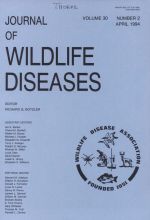We compared three transport methods for the recovery of Pasteurella haemolytica from pharyngeal swabs collected under field conditions from 42 bighorn sheep (Ovis canadensis) in one captive and three free-ranging populations. Transport methods included: Amies medium with charcoal, transported on ice, and cultured on blood agar within 24 hr; direct plating on blood agar, transported on heating pads, and incubated at 37 C within 8 hr of collection; and phosphate buffered glycerol (PBG), transported on dry ice, and stored at − 70 C for 10 days before culture. Isolates of P. haemolytica were recovered from all 42 bighorn sheep with a mean (±SE) of 1.2 ± 0.1 (Amies), 1.3 ± 0.1 (blood agar), and 1.3 ± 0.1 (PBG) isolates per swab. No statistical differences (P > 0.05) were observed in the recovery of P. haemolytica isolates among the transport methods. However, based on our experience and results of this study, we recommend that if submission of samples to the laboratory is likely to be delayed, pharyngeal swabs be transported in PBG on dry ice and kept frozen until they are cultured. Viable samples can be maintained in PBG at − 70 C for several years.
How to translate text using browser tools
1 April 1994
A Reliable Transport Method for Isolating Pasteurella haemolytica from Bighorn Sheep
William J. Foreyt,
John E. Lagerquist

Journal of Wildlife Diseases
Vol. 30 • No. 2
April 1994
Vol. 30 • No. 2
April 1994
bacterial transport methods
Bighorn Sheep
Ovis canadensis
Pasteurella haemolytica
pharyngeal swabs
phosphate buffered glycerol




